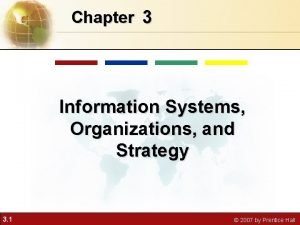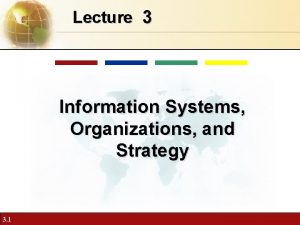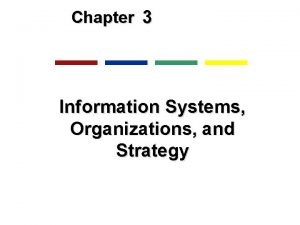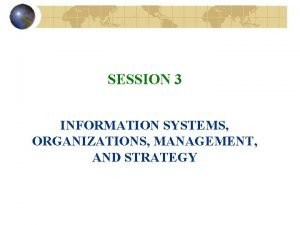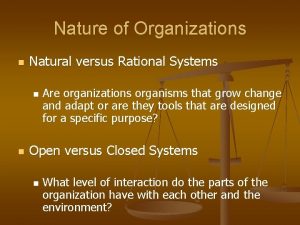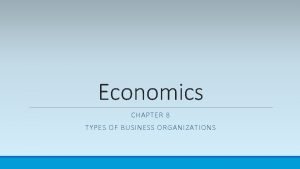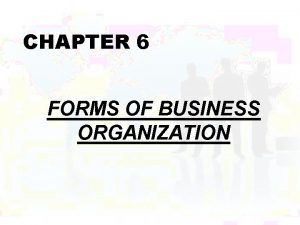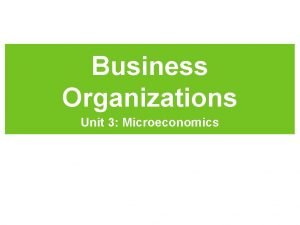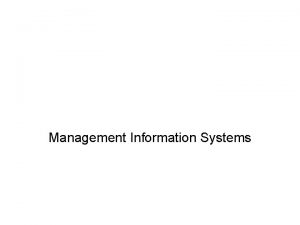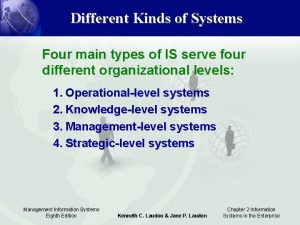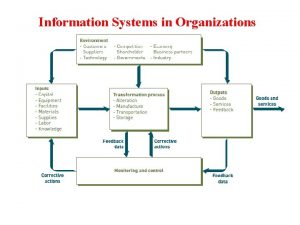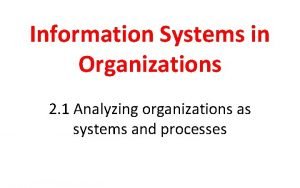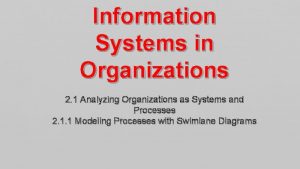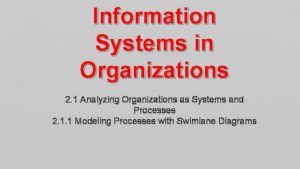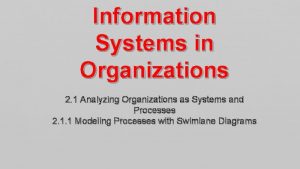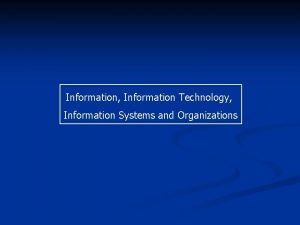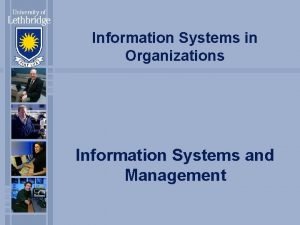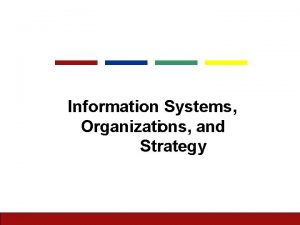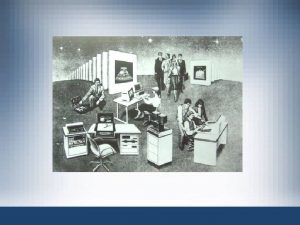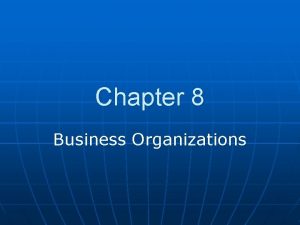Types of information systems in organizations and its






















- Slides: 22

Types of information systems in organizations and its characteristics Faculty of Business, Finance, and Hospitality Prepared by: Teo Siew Copyright© 2017 MAHSA UNIVERSITY

Learning Objectives • Evaluate the role played by systems serving the various levels of management in a business and their relationship to each other. • Explain how enterprise applications improve organizational performance.

Information Systems in Business Functions • Functional business area: services within a company that support main business • Includes accounting, finance, marketing, human resources, etc. • Part of a larger enterprise system 3

Accounting • Accounting information systems: • • • Help record transactions Produce periodic statements Create required reports for law Create supplemental reports for managers Contain controls to guarantee adherence to standards 4

Finance • Finance systems: • Facilitate financial planning and business transactions • Tasks include organizing budgets, managing cash flow, analyzing investments, and making decisions 5

Marketing • Marketing’s purpose is to pinpoint likely customers and promote products • Marketing information systems help: • Analyze demand for products in regions and demographic groups • Identify trends in demand for products/services • Determine how advertising campaigns affect profit • Web provides opportunity to collect marketing data as well as promote products and services 6

Human Resources • Human resource (HR) management systems assist in: • Record-keeping • Employee evaluation • Employee benefits 7

Types of Information Systems • Transaction processing systems • Serve operational managers and staff • Perform and record daily routine transactions necessary to conduct business • Examples: sales order entry, payroll, shipping • Allow managers to monitor status of operations and relations with external environment • Serve predefined, structured tasks, resources and goals for decision making

Types of Information Systems • Transaction processing systems • Major producers of information for other types of systems. • Central to a business

A Payroll TPS A TPS for payroll processing captures employee payment transaction data (such as a time card). System outputs include online and hard-copy reports for management and employee paychecks. FIGURE 2 -2

Types of Information Systems • Management information systems • Serve middle management • help with monitoring, controlling, decision making, and administrative activities. • Provide reports on firm’s current performance, based on data from TPS • Provide answers to routine questions with predefined procedure for answering them • Typically have little analytic capability

How MIS Obtain Their Data from the Organization’s TPS FIGURE 2 -3 In the system illustrated by this diagram, three TPS supply summarized transaction data to the MIS reporting system at the end of the time period. Managers gain access to the organizational data through the MIS, which provides them with the appropriate reports.

Sample MIS Report FIGURE 2 -4 This report, showing summarized annual sales data, was produced by the MIS in Figure 2 -3.

Types of Information Systems • Decision support systems • Serve middle management • Support non-routine decision making • Example: What is the impact on production schedule if December sales doubled? • • May use external information as well TPS / MIS data Provide sophisticated analytical models and data analysis tools Focus on problems that are unique and rapidly changing Are designed so that users can work with them directly

Voyage-Estimating Decision Support System FIGURE 2 -5 This DSS operates on a powerful PC. It is used daily by managers who must develop bids on shipping contracts.

Types of Information Systems • Executive support systems • Support senior management • Address non-routine decisions • Requiring judgment, evaluation, and insight • Incorporate data about external events (e. g. new tax laws or competitors) as well as summarized information from internal MIS and DSS • Provide a generalized computing and communications capacity that can be applied to a changing array of problems • Are designed for ease-of-use and rely heavily on graphical presentations of data

Types of Information Systems • Knowledge management systems (KMS) • Support processes for capturing and applying knowledge and expertise • How to create, produce, deliver products and services • Collect internal knowledge and experience within firm and make it available to employees • Link to external sources of knowledge

Types of Information Systems • Knowledge management systems (KMS) • Enable: • support processes for acquiring, storing, distributing, and applying knowledge • managing and distributing documents, graphics, and other digital knowledge objects • systems for creating corporate knowledge directories of employees with special areas of expertise • office systems for distributing knowledge and information • knowledge work systems to facilitate knowledge creation • use intelligent techniques that codify knowledge and experience for use by other members

Types of Information Systems • Expert System: supports knowledge-intensive decision making • Uses artificial intelligence techniques • Can preserve the knowledge of retiring experts

Types of Information Systems • Enterprise systems • Also known as enterprise resource planning (ERP) • Collects data from different firm functions and stores data in single central data repository • Resolves problem of fragmented data • Enable: • Coordination of daily activities • Efficient response to customer orders (production, inventory) • Help managers make decisions about daily operations and longer-term planning

Web-Empowered Enterprises • E-commerce: buying and selling goods and services through Internet • Internet is a vast network of computers connected globally • Web has a profound impact on information systems • A place to conduct e-commerce • An emerging advertising medium © Cengage Learning 2015 21

References • Kenneth C. Laudon & Jane P. Laudon (2015) Management Information System: Managing the Digital Firm, 14 th edition. Pearson.
 Information systems, organizations, and strategy
Information systems, organizations, and strategy Information systems, organizations, and strategy
Information systems, organizations, and strategy Information systems, organizations, and strategy
Information systems, organizations, and strategy Information systems organizations and strategy
Information systems organizations and strategy Chapter 3 information systems organizations and strategy
Chapter 3 information systems organizations and strategy Natural system organization example
Natural system organization example Chapter 8 business organizations
Chapter 8 business organizations 6 types of business organizations
6 types of business organizations Three types of business organizations
Three types of business organizations 6 types of business ownership
6 types of business ownership Types of organizations
Types of organizations Types of health services
Types of health services Management information system topics
Management information system topics Types of information systems
Types of information systems Voyage estimating decision support system
Voyage estimating decision support system Marketing information management definition
Marketing information management definition Types of information systems
Types of information systems The emigree and london comparison
The emigree and london comparison Its halloween its halloween the moon is full and bright
Its halloween its halloween the moon is full and bright When a train increases its velocity, its momentum
When a train increases its velocity, its momentum Sunny windy cloudy rainy
Sunny windy cloudy rainy If its a square it's a sonnet summary
If its a square it's a sonnet summary Its not easy but its worth it
Its not easy but its worth it
